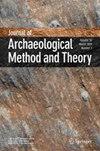Modelling Mobility of Hunter-Gatherer Populations: A Dynamic Simulation Approach Based on Cellular Automata.
IF 2.8
1区 历史学
Q1 ANTHROPOLOGY
引用次数: 0
Abstract
Understanding mobility of past hunter-gatherer populations requires dynamic approaches which incorporate uncertainty. Least cost models assume complete knowledge of the terrain on the part of the traveller, while ethnographic examples tend to be specific to the groups and territories studied. Most least cost models also assume that origin points, destination points, or both, are known in advance, limiting their utility for exploring movement potential in landscapes where evidence for occupation is scarce. This research addresses these limitations through an agent-based model of movement grounded in cellular automata (CA) theory, called DISPERSCA. Agents depart from a point, which may be specified or determined at random, and transit a fitness landscape for a fixed number of iterations according to decisions made within a defined area at each time step (a decision catchment), the CA neighbourhood. If the decision catchment is unknown multiple runs are made at different CA neighbourhood sizes and the results are compared. Neighbourhoods may be square or hexagonal, the former producing on average longer displacements, the latter ensuring that individual walks are of equal length in any direction. The model is demonstrated by application to Late Pleistocene Central Iberia, where confirmed archaeological sites are scarce. Some support can be advanced for the hypothesis that the Central Iberian mountains, probably combined with the Iberian System range, presented a significant barrier to hunter-gatherer groups. The model can be modified to account for agents' prior knowledge, or to include fitness variables unrelated to terrain cost, such as water, the presence of game animals or vegetation.狩猎采集者群体流动性建模:基于元胞自动机的动态模拟方法。
了解过去狩猎采集者群体的流动性需要包含不确定性的动态方法。最低成本模型假设旅行者完全了解地形,而民族志的例子往往是特定于研究的群体和领土。大多数最小成本模型还假设原点、终点或两者都是事先已知的,这限制了它们在缺乏占领证据的景观中探索运动潜力的效用。本研究通过基于元胞自动机(CA)理论的基于agent的运动模型(称为DISPERSCA)解决了这些限制。智能体从一个点出发,这个点可能是随机指定或确定的,并根据在每个时间步(决策集区),即CA邻域,在定义区域内所做的决策,在固定次数的迭代中传输适应度景观。如果决策集水区未知,则在不同CA邻域大小下进行多次运行,并比较结果。街区可以是方形的,也可以是六角形的,前者平均产生较长的位移,后者确保个人在任何方向上的行走长度相等。该模型通过在晚更新世伊比利亚中部的应用得到了验证,那里确认的考古遗址很少。可以提出一些支持假设,即中部伊比利亚山脉,可能与伊比利亚系统范围相结合,对狩猎采集者群体构成了重大障碍。该模型可以修改为考虑代理的先验知识,或者包括与地形成本无关的适应度变量,如水、游戏动物或植被的存在。
本文章由计算机程序翻译,如有差异,请以英文原文为准。
求助全文
约1分钟内获得全文
求助全文
来源期刊
CiteScore
6.30
自引率
8.70%
发文量
43
期刊介绍:
The Journal of Archaeological Method and Theory, the leading journal in its field, presents original articles that address method- or theory-focused issues of current archaeological interest and represent significant explorations on the cutting edge of the discipline. The journal also welcomes topical syntheses that critically assess and integrate research on a specific subject in archaeological method or theory, as well as examinations of the history of archaeology. Written by experts, the articles benefit an international audience of archaeologists, students of archaeology, and practitioners of closely related disciplines. Specific topics covered in recent issues include: the use of nitche construction theory in archaeology, new developments in the use of soil chemistry in archaeological interpretation, and a model for the prehistoric development of clothing. The Journal''s distinguished Editorial Board includes archaeologists with worldwide archaeological knowledge (the Americas, Asia and the Pacific, Europe, and Africa), and expertise in a wide range of methodological and theoretical issues. Rated ''A'' in the European Reference Index for the Humanities (ERIH) Journal of Archaeological Method and Theory is rated ''A'' in the ERIH, a new reference index that aims to help evenly access the scientific quality of Humanities research output. For more information visit: http://www.esf.org/research-areas/humanities/activities/research-infrastructures.html Rated ''A'' in the Australian Research Council Humanities and Creative Arts Journal List. For more information, visit: http://www.arc.gov.au/era/journal_list_dev.htm

 求助内容:
求助内容: 应助结果提醒方式:
应助结果提醒方式:


